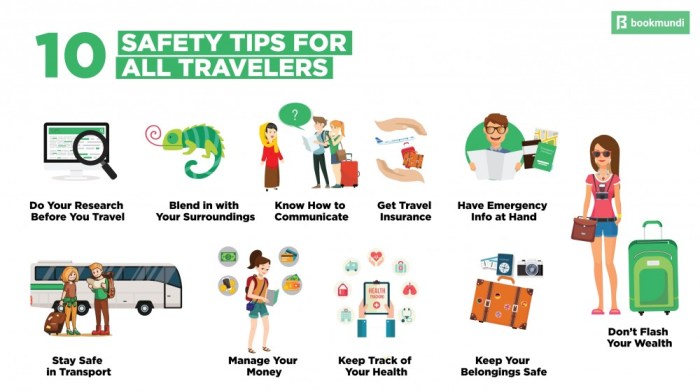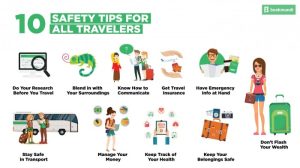
Embarking on a group travel adventure? Stay safe and informed with these essential tips for a smooth and enjoyable journey. From pre-travel planning to emergency preparedness, we’ve got you covered. Let’s dive in!
Importance of Group Travel Safety Tips
Group travel safety tips are essential for ensuring a successful and enjoyable trip for all participants. By following proper safety measures, you can significantly reduce the risk of accidents, emergencies, or mishaps during the journey.
Impact of Safety Measures
Statistics show that group travel safety tips can make a significant difference in the overall travel experience. For example, studies have shown that groups who adhere to safety protocols are less likely to encounter incidents such as theft, accidents, or health emergencies.
Additionally, real-life examples demonstrate the importance of safety precautions during group travel. For instance, a group that follows safety guidelines may avoid getting lost in an unfamiliar location, minimize the chances of falling victim to scams, or prevent injuries during adventurous activities.
Enhancing Travel Experience
Proper safety precautions not only ensure the physical well-being of group members but also contribute to a more relaxed and enjoyable travel experience. When everyone feels secure and protected, they can focus on exploring new destinations, trying local cuisines, and creating lasting memories together.
Pre-Travel Planning for Group Safety

Effective pre-travel planning is crucial to ensure the safety and well-being of everyone in a group. By taking the necessary steps before embarking on a trip, you can mitigate risks and address potential challenges that may arise during group travel.
Identifying Potential Risks
Before setting off on a group trip, it’s essential to identify potential risks specific to group travel. These may include:
- Lost or separated group members
- Medical emergencies
- Natural disasters or inclement weather
By recognizing these risks, you can develop strategies to mitigate them and ensure the safety of everyone in the group.
Tools and Resources for Planning
There are various tools and resources available to aid in planning group travel safety effectively. Some of these include:
- Group safety apps: Utilize apps that allow for real-time communication and location sharing among group members.
- Emergency contact list: Create a comprehensive list of emergency contacts for each member of the group.
- Travel insurance: Invest in travel insurance that covers medical emergencies, trip cancellations, and other unforeseen events.
By leveraging these tools and resources, you can enhance the safety and security of your group during travel.
Communication Strategies Within a Travel Group
Clear communication among group members during travel is crucial for ensuring everyone’s safety and well-being. It helps keep everyone informed, coordinated, and prepared for any situation that may arise. Effective communication methods play a vital role in fostering a sense of unity and responsibility within the group.
Importance of Clear Communication
Effective communication methods within a travel group include:
- Establishing a designated group leader or point of contact: Having a clear leader can streamline decision-making processes and ensure that important information is disseminated efficiently.
- Setting up a group chat or communication channel: Utilizing messaging apps like WhatsApp or GroupMe can help keep everyone connected and informed about the itinerary, meeting points, and any changes to the plan.
- Implementing a buddy system: Pairing up group members can ensure that everyone has a buddy to look out for them, especially in crowded or unfamiliar environments.
- Utilizing location-sharing apps: Apps like Find My Friends or Google Maps allow group members to track each other’s whereabouts in real-time, providing an added layer of safety and security.
Utilizing Technology for Communication
Technology and apps can greatly facilitate communication and coordination within a travel group. For example:
- Group messaging apps: Apps like Slack or Telegram allow for quick and easy communication among group members, enabling real-time updates and information sharing.
- Trip planning apps: Platforms such as TripIt or Google Trips can centralize all travel information, including itineraries, reservations, and important contacts, making it easily accessible to everyone in the group.
- Emergency alert apps: Apps like GeoSure or Safeture provide safety ratings and alerts for different locations, helping group members stay informed about potential risks or hazards in their vicinity.
Emergency Preparedness and Response
In group travel situations, it is crucial to have a detailed emergency plan in place to ensure the safety and well-being of all members. Being prepared for unexpected incidents can make a significant difference in the outcome of an emergency.
Roles and Responsibilities
- Designate a group leader or emergency coordinator who will be responsible for making decisions and coordinating actions in case of an emergency.
- Assign specific roles and responsibilities to each group member, such as first aid provider, communication liaison, or navigator.
- Ensure that everyone is aware of their roles and knows how to execute them effectively in an emergency situation.
Tips for Staying Calm and Acting Swiftly
- Remain calm and composed to think clearly and make rational decisions in high-stress situations.
- Follow the instructions of the group leader or emergency coordinator to maintain order and organization during an emergency.
- Communicate effectively with other group members to share important information and coordinate actions efficiently.
- Be prepared to assist others in need, prioritize safety, and act swiftly to address the emergency effectively.
Cultural Tourism
When it comes to group travel safety, understanding the local culture of the destination plays a crucial role. Cultural tourism can enhance the overall travel experience for the group while also ensuring their safety.
Cultural Norms and Practices
- Respect for local customs and traditions is essential to avoid any misunderstandings or conflicts. For example, in some countries, it may be disrespectful to show public displays of affection.
- Learning basic phrases in the local language can help travelers communicate effectively and show respect to the locals. This can also prevent any language barriers that might compromise the group’s safety.
- Awareness of dress codes is important, as some cultures have specific clothing requirements for religious or social reasons. Adhering to these norms can prevent unwanted attention or discomfort for the group.
- Understanding the local etiquette around greetings, gestures, and social interactions can help travelers navigate social situations with ease and prevent any misunderstandings that could lead to safety concerns.
Eco-Tourism
Eco-tourism focuses on responsible travel practices that minimize the negative impact on the environment and support conservation efforts. When it comes to group travel safety, embracing eco-tourism principles can significantly enhance the overall experience and ensure the well-being of both travelers and the natural surroundings they visit.
Impact of Eco-Tourism on Group Travel Safety
- By following eco-friendly practices such as reducing waste, conserving energy, and respecting wildlife habitats, group travelers can contribute to a safer and healthier environment for themselves and future generations.
- Choosing eco-friendly accommodations and transportation options can also enhance safety by supporting sustainable businesses that prioritize the well-being of their guests and the local ecosystem.
- Engaging in eco-tourism activities that promote environmental awareness and conservation can help group members develop a deeper appreciation for nature, leading to more responsible behavior and safer travel practices.
Eco-Friendly Safety Tips for Groups
- Carry reusable water bottles and snacks to reduce single-use plastic waste and minimize environmental impact during group excursions.
- Use biodegradable toiletries and cleaning products to ensure that group members leave minimal traces behind in natural areas they visit.
- Stay on designated trails and follow local regulations to protect sensitive ecosystems and prevent accidents or injuries while exploring nature reserves or wildlife habitats.
Preserving Natural Environments for Group Safety
- Respecting wildlife and refraining from feeding or approaching animals can help maintain a safe distance and prevent potentially dangerous encounters during group outings in natural settings.
- Supporting conservation initiatives and local communities through eco-tourism activities can contribute to the preservation of natural environments, ensuring the safety and sustainability of group travel experiences in the long run.
Culinary Travel
Traveling with a group provides a unique opportunity to explore the culinary delights of various destinations. However, it is essential to consider safety measures and hygiene practices when indulging in culinary experiences as a group.
Safety Considerations
- Always choose reputable and clean restaurants or food vendors to minimize the risk of foodborne illnesses.
- Check reviews or ask locals for recommendations to ensure the quality and safety of the food establishments.
- Avoid consuming raw or undercooked foods, especially meats and seafood, to prevent food poisoning.
Ensuring Food Safety and Hygiene
- Encourage group members to wash their hands before and after meals, or provide hand sanitizers for everyone.
- Inspect the cleanliness of utensils and serving dishes before using them to avoid contamination.
- Ensure that all group members are aware of basic food safety practices, such as avoiding cross-contamination and proper storage of leftovers.
Accommodating Dietary Preferences or Restrictions
- Prior to the trip, gather information on the dietary needs and restrictions of group members to plan meals accordingly.
- Communicate with restaurants or food establishments in advance to accommodate special dietary requests, such as vegetarian, gluten-free, or allergy-friendly options.
- Consider carrying snacks or portable meals for individuals with specific dietary requirements to ensure they have safe and suitable food options throughout the trip.
Historical Travel

Exploring historical sites during group travel can be both educational and exciting. However, it’s essential to take specific safety precautions to ensure a smooth and enjoyable experience. Navigating historical landmarks with a group requires careful planning and awareness of potential risks. Understanding the historical context of these destinations can also provide valuable insights into safety measures that need to be taken.
Safety Precautions for Historical Sites
When visiting historical sites with a group, it’s crucial to stay together and follow the designated paths or trails. Be mindful of any uneven terrain, steep steps, or low-hanging structures that could pose a tripping hazard. It’s also advisable to listen to tour guides or local authorities for any safety instructions or warnings.
Navigating Landmarks Safely
Before exploring historical landmarks, ensure that everyone in the group is aware of the meeting points and emergency contact information. Establish a buddy system to ensure that no one gets lost or left behind. Stay together as a group, especially in crowded or unfamiliar areas, and avoid wandering off alone.
Significance of Historical Context
Understanding the historical context of the sites you are visiting can help in identifying potential safety risks. By learning about the events that took place in a particular location, you can better appreciate the significance of certain safety measures or restrictions. Respect the cultural heritage of these sites and follow any rules or guidelines set forth to protect them.
Luxury Travel
When it comes to luxury group travel experiences, safety considerations take on a unique dimension. While indulging in lavish accommodations, gourmet dining, and exclusive activities, it’s essential to ensure that safety remains a top priority for the group.
Safety Standards and Services in Luxury Travel
Luxury travel providers often go above and beyond to provide exceptional safety standards and services for group trips. From private transportation with professional drivers to 24/7 concierge assistance, these providers prioritize the well-being and security of their guests.
Maintaining Safety in Luxury Travel
- Choose reputable luxury travel providers with a proven track record of prioritizing safety.
- Ensure that the accommodations and activities included in the itinerary meet high safety standards.
- Stay informed about the local safety regulations and potential risks in the destination.
- Keep emergency contact information handy and communicate emergency procedures with all group members.
- Opt for travel insurance that covers medical emergencies, trip cancellations, and other unforeseen circumstances.
Budget Travel
When it comes to group travel, budget constraints can significantly impact the safety measures that can be implemented. While saving money is important, it is equally essential to prioritize the safety and well-being of all group members during budget travel experiences. Finding a balance between cost-effectiveness and ensuring the safety of the group is crucial.
Cost-Effective Safety Tips for Budget-Conscious Group Travelers
- Research affordable accommodation options that still meet safety standards.
- Opt for public transportation or shared rides to save on transportation costs while ensuring group safety.
- Plan meals in advance and consider cooking meals together to save on food expenses.
- Carry a basic first aid kit and emergency supplies without overspending on elaborate medical kits.
- Stay informed about any travel advisories or safety concerns in the destination without relying on expensive travel agencies.
Backpacking
When embarking on a group backpacking adventure, safety should always be a top priority. Here are some essential safety tips tailored to group backpacking trips to ensure a smooth and secure journey.
Importance of Lightweight Safety Gear
Carrying lightweight safety gear is crucial for group backpacking trips as it allows for easier mobility and reduces strain on the body. Opt for compact, multi-functional items that can serve multiple purposes to minimize the weight of your backpack.
Emergency Essentials for Group Backpacking
When venturing into the wilderness as a group, it’s important to be prepared for any unforeseen circumstances. Make sure to carry essential emergency items such as:
- First aid kit with basic supplies
- Emergency shelter (tent or emergency blanket)
- Portable water filtration system
- Extra food rations
- Navigation tools (map, compass, GPS)
- Emergency communication device (satellite phone or locator beacon)
Being equipped with these emergency essentials can make a significant difference in ensuring the safety and well-being of your group during a backpacking trip.
Solo Travel
When it comes to solo travel, there are unique safety considerations that travelers need to keep in mind. Unlike group travel where there is safety in numbers, solo travelers must rely solely on themselves for their safety and well-being. However, there are ways to enhance safety while traveling solo.
Comparing Solo and Group Travel
- Solo travel can offer more flexibility and independence compared to group travel.
- In group travel, there is a sense of security and support from traveling with others.
- Solo travelers may need to be more vigilant and cautious in unfamiliar environments.
Benefits of Traveling Solo Within a Group
- Joining group activities or tours while traveling solo can provide a sense of community and companionship.
- Traveling with a group for certain activities or excursions can enhance safety by having others around in case of emergencies.
- Group travel can offer opportunities to meet new people and make connections while still having the freedom to explore independently.
Tips for Solo Travelers Enhancing Safety
- Consider joining group tours or activities to explore new destinations, especially in areas with safety concerns.
- Inform a trusted person about your travel itinerary and check in regularly to stay connected.
- Research local customs and safety tips specific to your destination to stay informed and prepared.
- Trust your instincts and avoid risky situations or environments while traveling solo.
Group Travel
When it comes to group travel, ensuring safety is paramount to having a successful and enjoyable experience. Here are some key takeaways for staying safe during group travel adventures:
Safety Tips for Group Travel
- Designate a group leader: Having a designated leader can help streamline decision-making and ensure everyone is on the same page.
- Establish communication protocols: Set up a system for staying in touch, especially in crowded or unfamiliar places.
- Create a group emergency plan: Make sure everyone knows what to do in case of emergencies and where to meet up.
- Stay together: Avoid wandering off alone and make sure to stick together as a group.
- Be aware of your surroundings: Stay vigilant and alert to potential risks or dangers.
Group Travel Safety Planning Checklist
- Confirm travel details: Check and double-check travel arrangements, accommodations, and itineraries.
- Share emergency contacts: Ensure everyone has a list of emergency contacts and knows how to reach them.
- Pack essential items: Make sure to pack necessary medications, first aid supplies, and important documents.
- Review local laws and customs: Familiarize yourself with the local laws and customs of your destination to avoid any misunderstandings.
- Stay informed: Keep updated on weather conditions, local news, and any potential safety hazards in the area.
Success Stories of Group Travel Safety
“Thanks to our thorough safety planning and communication strategies, we were able to handle a medical emergency during our group trip smoothly and efficiently.”
“By following the group travel safety checklist, we were able to navigate through a challenging situation in a foreign country with ease and confidence.”
Summary
In conclusion, prioritizing safety in group travel ensures a memorable and stress-free experience for all. By following these tips and guidelines, you can make the most of your travels without compromising on well-being. Stay safe and happy exploring!
Questions Often Asked
How can group travel safety tips enhance the overall travel experience?
Group travel safety tips ensure a smooth and stress-free journey, allowing all members to focus on enjoying the trip without worries about their well-being.
What are some effective communication strategies for ensuring safety within a travel group?
Clear communication, setting meeting points, using group messaging apps, and regular check-ins can help ensure everyone’s safety and coordination within the group.
How can travelers accommodate dietary preferences or restrictions during group culinary experiences?
Group members can communicate their dietary needs in advance, research restaurants with diverse menu options, or opt for customizable meals to ensure a safe and enjoyable culinary travel experience.
What are some cost-effective safety tips for budget-conscious group travelers?
Opting for accommodations in safe and well-reviewed areas, carrying a basic first aid kit, and being aware of local emergency numbers are some budget-friendly safety measures for group travelers.
How can solo travelers enhance their safety during group travel experiences?
Solo travelers can join group activities or tours, stay connected with the group, and follow safety protocols to enhance their security while enjoying the benefits of group travel.





